Polarization Measurements
|
Fundamental to an antenna's radiation pattern is its
polarization. On this page, we'll discuss
methods and techniques for measuring the polarization of an antenna. Note that the polarization varies depending on the
direction of radiation from an antenna. For instance, a circularly polarized antenna may be approximately circular
only over a narrow beamwidth, and linearly polarized away from the antenna's main beam (this is
often the case for circularly polarized
patch antennas). To perform the measurement, we will use our test antenna as the source. Then we will use a linearly polarized antenna (typically a half-wave dipole antenna) as the receive antenna. The linearly polarized receive antenna will be rotated, and the received power recorded as a function of the angle of the receive antenna. In this manner, we can gain information on the polarization of the test antenna. This received information only applies to the polarization of the test antenna for the direction in which the power is received. For a complete description of the polarization of the test antenna, the test antenna must be rotated so that the polarization can be determined for each direction of interest. The basic setup for polarization measurements is shown in Figure 1.
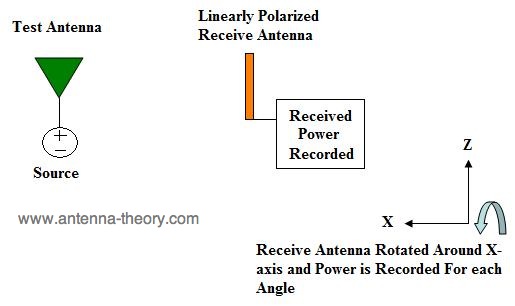 Figure 1. Basic setup for antenna polarization measurements. The power is recorded for the a fixed position (orientation) of the receive antenna, then it is rotated about the x-axis as shown in Figure 1, and the power is recorded again. This is done for a complete rotation of the linearly polarized receive antenna. From this information, a lot can be determined about the polarization of the test antenna. Lets look at a couple of cases. Suppose that the test antenna is vertically linearly polarized, and that the receive antenna is also vertically linearly polarized, and that the rotation angle zero has both antennas polarization matched. Then the output of our experiment, as a function of the rotation angle of the receive antenna, would look something like the graph shown in Figure 2.
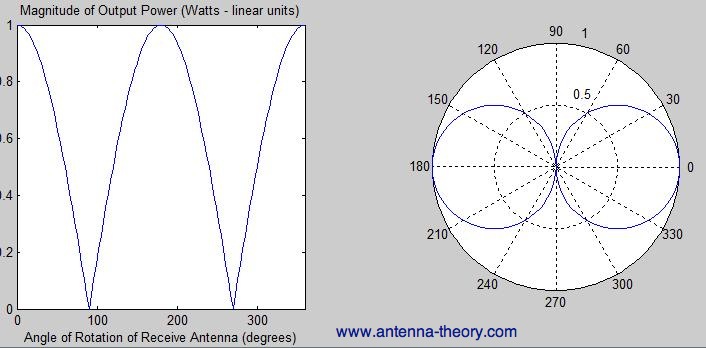 Figure 2. Output of Measurement when the Test Antenna is Linearly Polarized. Left: Rectangular Plot. Right. Polar Plot. The plots in Figure 2 give two views of the output. The left side gives an x-y plot of the output. The right side gives a polar plot, which may be helpful in visualizing the results. Note that the result is periodic - when the receive antenna is rotated 180 degrees, it is again vertically polarized so that the received power is identical. Suppose now that the test antenna was horizontally polarized - again linearly polarized, but initially not polarization matched to the receive antenna. Then the resulting received power plots would resemble that shown in Figure 3.
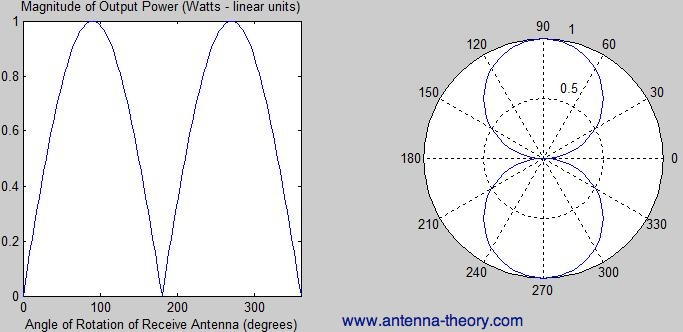 Figure 3. Output measurement of Linearly Polarized Test Antenna (Horizontal Pol). In this case, we see that the shape of the resulting measurements are the same, but that the peaks of the received power occur for different angles. As a result, we know that when the test antenna is linearly polarized, the received power will resemble the shapes shown in Figures 2 and 3, and by determining the angle in which the received power is at a peak, we can determine the angle of the linear polarization.
Suppose now that the test antenna was radiating a RHCP (Right Hand Circularly Polarized) wave. If the test antenna was subject to the same measurement as above, the normalized (make the peak output power equal to one for simplicity) output power would resemble that of Figure 4.
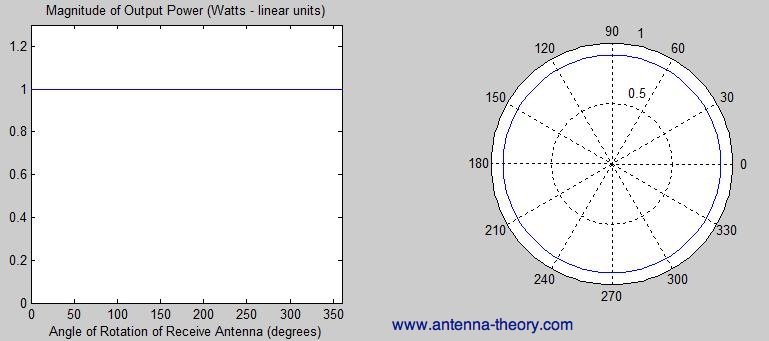 Figure 4. Output of Measurement when the Test Antenna is Circularly Polarized. Because a circularly polarized wave has equal amplitude components in two orthogonal directions, the received power is constant for a rotated linearly polarized antenna (incidentally, this is a feature of circular polarization that makes it attractive - you don't have to worry about getting the orientation right). Note also that the received power is the same whether or not the test antenna is left hand (LHCP) or right hand (RHCP). As a result, this method can determine the type of polarization, but can not determine the sense of rotation for the polarization. We will need another measurement to determine this, which is discussed later. In the meantime, lets look at another example. Suppose the test antenna is elliptically polarized, with a tilt angle of 45 degrees and an axial ratio of 3 dB. The E-field for this antenna might be described using the coordinate system of Figure 1 by the equation:
 The resulting output of the measurement experiment would be as shown in Figure 5.
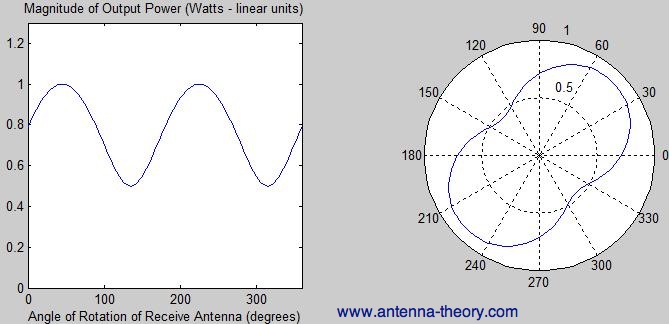 Figure 5. Output of Measurement when the Test Antenna is Elliptically Polarized (axial ratio = 3 dB, major axis along 45 degrees). Now its getting interesting. Isn't Figure 5 cool? I think so. First, we can tell the tilt angle of the elliptically polarized wave by where the received power is at a peak - in this case at 45 degrees, which can be seen from either figure. The other parameter of elliptical polarization - the axial ratio, can be determined as well from these plots. The ratio of the peak output (in this case 1.0 when the angle is 45 degrees) to the minimum power output (in this case 0.5, when the angle 8s 135 degrees) gives the axial ratio (1/0.5 = 2 = 3dB). Hence, by simply observing the plots and being aware of the types of polarization, we can quickly determine the type of polarization for this direction of the test antenna's radiation pattern. Again, note that we don't know the direction of rotation of the E-field (left or right). Finally, one more example. Suppose the axial ratio is 9 dB and the major axis of the ellipse is the z-axis. The result would resemble that of Figure 6.
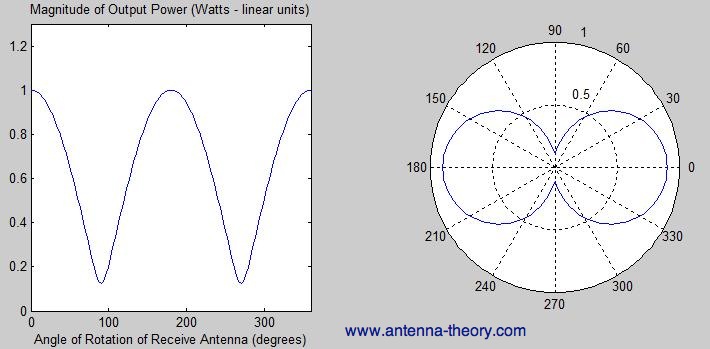 Figure 6. Output of Measurement when the Test Antenna is Elliptically Polarized (axial ratio = 9 dB, major axis along 0 degrees). Make sense? If not, read through this page again. Finally, we would like to determine the sense of polarization for the antenna under test. Suppose that the test antenna is RHCP, so that we get the output shown in Figure 4. We can't tell from this whether the result is RHCP or LHCP. A simple approach to determine the sense of rotation in this case is to use an antenna that is known to be RHCP as the receive antenna. The result is recorded, and then the measurement is performed again with a receive antenna that is LHCP. The result for the first case should be much larger than the output for the second case if the test antenna is RHCP. By selecting the polarization sense based on the output power that is larger, the sense of rotation for the polarization can be determined. The difficulty in this is that it requires two antennas at the frequency of interest that are closely RHCP and LHCP, which isn't always easy. The polarization could also be determined using a combination of phase measurements for two orthogonal directions in the radiation patterns and then comparing the results along with the magnitude of the received power. This technique won't be discussed in detail here, but you could probably piece together the required steps.
|
Antenna Measurements (Home)